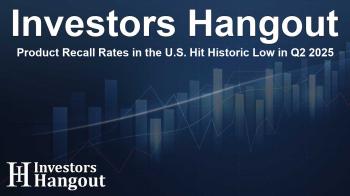Product Recall Rates in the U.S. Hit Historic Low in Q2 2025

U.S. Product Recall Trends in 2025
The latest data from Sedgwick reveals a significant decline in product recalls in the United States during the second quarter of 2025. With a remarkable 31.5% drop from the first quarter, the number of recalled products plummeted from 125.37 million to just 85.87 million. This reduction marks a pivotal moment, being the lowest quarterly figure observed since Q2 2022, and represents just one of five quarters in the last five years where recalls fell below 100 million units.
Surge in Recall Events
Despite the dramatic decrease in the volume of recalled products, the number of recall events witnessed a significant increase. Q2 2025 saw 861 recall events, the highest number recorded in more than a year. This contrasting trend of fewer units recalled alongside increased events suggests modifications in production practices, possibly due to smaller batch production, improved defect detection, and a growing culture of preparedness for recalls across various industries.
In-Depth Analysis by Sedgwick
Sedgwick's quarterly U.S. Product Safety and Recall Index offers a comprehensive evaluation of recall activities covering automotive, consumer products, food and beverages, pharmaceuticals, and medical devices. The second quarter report reviewed data accumulated from April to June and provided insight into trends that began to unfold in July, further enhancing understanding of the evolving market landscape.
First Half Overview
Over the first half of 2025, the overall recall events tally stood at 1,636, slightly lower than the 1,697 recorded during the same period in 2024. The number of units impacted during this period equaled 211.25 million, nearly half of the 384.17 million reported in the first half of 2024. This statistic signifies the lowest number of recalled units in a decade, highlighting a noteworthy shift in the industry.
Implications of Regulatory Changes
The latest Recall Index not only highlights recall data but also discusses regulatory developments influencing the second quarter, paving the way for expectations for the rest of 2025. Numerous regulatory agencies have proactively set forth new frameworks for government operations, emphasizing efficiency and responsiveness. Innovations promoted under the recent administration include reduced regulations and the introduction of new pilot programs utilizing AI technologies.
Challenges and Opportunities
Businesses in all sectors must be ready to adapt to ongoing governmental initiatives aimed at enhancing domestic manufacturing capabilities, expediting product launches, and strengthening product safety, particularly within the food and beverage sector. These objectives introduce both opportunities and challenges; while some regulations are being relaxed—such as those concerning vehicle emissions—others are being introduced, especially regarding post-market reviews and restrictions on various food ingredients.
Future of Product Safety
“As we navigate this rapidly evolving regulatory setting, product safety remains paramount for federal agencies,” stated Chris Harvey, Senior Vice President of Brand Protection at Sedgwick. He emphasized the importance of businesses evaluating their supply chains, pricing strategies, and compliance protocols in line with emerging oversight and enforcement practices. It remains critical for businesses to keep their recall and incident response strategies updated and ready for implementation at all times.
About Sedgwick
Sedgwick is a premier partner in risk and claims administration, dedicated to helping clients thrive despite unexpected challenges. Their expertise and advanced AI-enabled technologies set benchmarks in solutions for claims administration, loss adjusting, benefits management, and product recall initiatives. With a dedicated team of over 33,000 global colleagues and partnerships with 10,000 clients across 80 countries, Sedgwick is equipped to tackle the intricate and ever-changing risk landscape. The company's majority share is held by The Carlyle Group, with notable minority investments from Stone Point Capital LLC, Altas Partners, CDPQ, Onex, and other management investors.
Frequently Asked Questions
What was the main finding of the Sedgwick recall index for Q2 2025?
The Sedgwick index reported a 31.5% decline in recalled products in Q2 2025, with a total of 85.87 million units, marking a historic low.
How did the number of recall events change in Q2 2025?
Despite fewer units being recalled, the number of recall events actually increased to 861, the highest quarterly total in over a year.
What factors contributed to the decline in recalled units?
The decline is attributed to smaller production batches, improved defect detection methods, and a proactive culture of recall readiness.
How does the Recall Index support businesses?
The Recall Index provides valuable insights and analytics on recall activities across multiple sectors, aiding companies in navigating regulatory environments.
What opportunities and challenges do regulations present?
While some regulations are being relaxed, such as those regarding emissions, new restrictions on food safety are being introduced, demanding businesses to adapt quickly.
About The Author
Contact Addison Perry privately here. Or send an email with ATTN: Addison Perry as the subject to contact@investorshangout.com.
About Investors Hangout
Investors Hangout is a leading online stock forum for financial discussion and learning, offering a wide range of free tools and resources. It draws in traders of all levels, who exchange market knowledge, investigate trading tactics, and keep an eye on industry developments in real time. Featuring financial articles, stock message boards, quotes, charts, company profiles, and live news updates. Through cooperative learning and a wealth of informational resources, it helps users from novices creating their first portfolios to experts honing their techniques. Join Investors Hangout today: https://investorshangout.com/
The content of this article is based on factual, publicly available information and does not represent legal, financial, or investment advice. Investors Hangout does not offer financial advice, and the author is not a licensed financial advisor. Consult a qualified advisor before making any financial or investment decisions based on this article. This article should not be considered advice to purchase, sell, or hold any securities or other investments. If any of the material provided here is inaccurate, please contact us for corrections.

